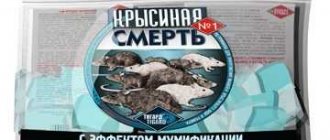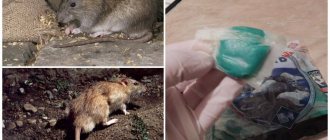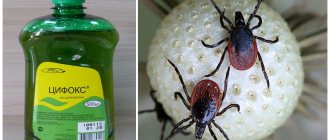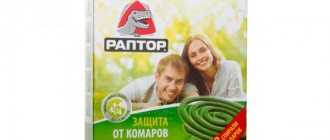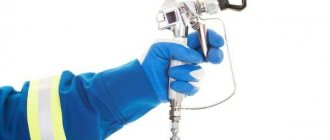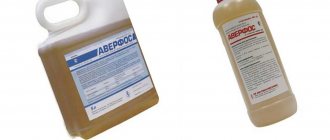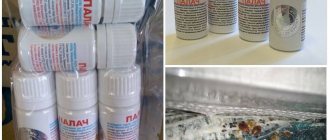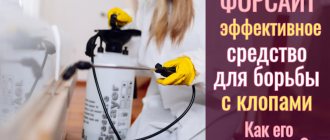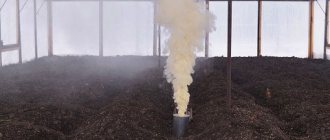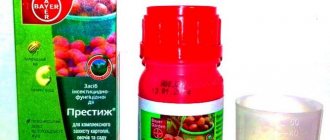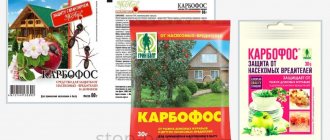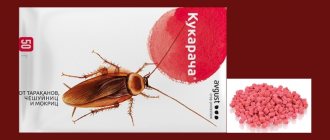Today, Rat Death No. 1 is a popular, fairly effective and inexpensive means of controlling rodents. Moreover, in terms of reliability and ease of use, this drug is often superior to poisons based on traditional poisons. However, the relatively high effectiveness of the drug against rats and mice is associated with its high toxicity for humans and domestic animals in general. For this reason, even despite the seemingly obvious procedure for use, when working with Rat Death, you must strictly follow the instructions for use, the important nuances of which we will talk about below.
The product can poison rats and mice both at home and in various industrial enterprises, retail premises and catering establishments. The method of using Rat Death and, as practice shows, the effectiveness of the drug practically do not depend on the type of object on which it is used, however, for successful pest control in each specific case, the correct calculation of the amount of the product is required.
Review
“...The task was this: to buy rat poison so that it does not stink at all, does not come under the feet of the cleaning lady in the office and in the production hall, but at the same time so that it works. I was appointed buyer. Apparently, they realized that I would not receive kickbacks on such a purchase. As a result, I bought the drug Rat Death 1. I don’t know, maybe there is Rat Death 2, but the first option suited us. I used all the allocated money to buy 45 packages, enough for all the premises, and then enough to add new packages instead of the chewed ones. At first I was confused by these bags with pieces that looked like plasticine, I thought that this was some kind of new method. I thought the rats wouldn't fall for them. But no, they took the bait, they literally went on a hunt for these packages. So what's the result? After about a couple of weeks, we stopped noticing the rats, although sometimes we came across their fresh excrement. And a month later there were no traces of their activity left. In the hall, under one control panel, a dead rat began to stink, it was very unpleasant, I had to lift the floorboards and get it out. But overall the poison is good, I can recommend it.”
Mikhail Dmitrievich, Moscow
Rat Death No. 1 is produced by the Ukrainian company, whose production facilities are located in Dnepropetrovsk. It is not known what prompted the owners of the company to choose such an original name for it, but the manufacturer himself reports that the product is produced on Italian and German equipment, and substances purchased in Italy are used as active ingredients.
Like many other products based on blood anticoagulants, Rat Death No. 1 is produced in the form of dough-like briquettes packaged in odor-permeable filter paper (in turn, all this is packaged in a dense polymer film). Natural flavors, flour, vegetable oil and sugar are used as auxiliary components in the preparation - additives that increase the attractiveness of the product for rodents.
On a note
Practice shows that Rat Death No. 1 is effective primarily against rats, since they prefer products that resemble meat, sausage or fish in appearance and consistency. But granivorous pests - mice and voles - are less willing to eat this poison, although with due persistence you can get rid of them with its help.
It should be borne in mind that Rat Death No. 2 is also available for sale - let’s take a closer look at the differences between this drug and Rat Death No. 1...
Rat Death #1 and Rat Death #2: What's the difference?
Fundamentally, Rat Death No. 1 and Rat Death No. 2 differ in their active ingredients: the active ingredient in the first drug is brodifacoum, and in the second, bromadiolone.
For the rat fighter himself, this distinction is important because bromadiolone is more toxic to rats. And since a smaller amount of poison is required to poison one animal, Rat Death 2, generally speaking, is more rational to purchase and use.
Also, Rat Death number 1 is blue-green in color, while Rat Death number 2 looks more like pieces of meat. Which, by the way, makes the second poison even more attractive to rats.
The photo below shows Rat Death #1:
And here is Rat Death No. 2:
The price of both poisons is approximately the same: they cost about 70 rubles for a package of 8 briquettes (weighing 100 grams) or about 120 rubles for a package of 16 briquettes (weighing 200 grams).
On a note
As mentioned above, in general, Rat Death No. 2 is preferable for use - also for the reason that the bromadiolone used in it is less hazardous to the environment. In particular, when recycling the remains of the product or rats poisoned by it, the load on soil biocenoses is reduced. At the same time, according to environmentalists, brodifacoum (contained in Rat Death No. 1) poses a great danger to the environment. For this reason, producing bromadiolone in Italy requires less regulatory approval and is more economical than producing brodifacoum for Rat Death #1.
Consequences of desomorphine
Toxic components, codeine, have a negative effect on the entire body and reduce immunity. The most dangerous consequences for life and health are:
- destruction of vessel walls, formation of blood clots;
- heart rhythm disturbances, cardiovascular failure;
- stroke, heart attack;
- putrefactive processes, tissue necrosis, gangrene;
- pneumonia, respiratory failure;
- secondary infection with syphilis, AIDS, HIV;
- tooth loss, decay of the jawbone;
- osteoporosis, arthritis;
- gastrointestinal ulcer;
- anorexia;
- renal failure;
- cirrhosis, liver dysfunction;
- cerebral edema;
- mental illnesses with symptoms indistinguishable from schizophrenia.
Desomorphine has a general destructive effect on the body. Depresses mental and physical health, which inevitably leads to death. The causes of death most often are drug overdose, gangrene, respiratory, cardiac, renal and liver failure, as well as suicide against the background of realistic severe hallucinations.
All types of drug addiction
Drug addiction treatment
More details
Female, age, beer
Treatment of alcoholism
More details
Active substances of drugs and their effect on rats
Both brodifacoum and bromadiolone are anticoagulant rodenticides. When they enter the rat's liver, they interfere with the formation of vitamin K, which is responsible for blood clotting. A lethal dose of an anticoagulant leads to the development of extensive hemorrhages in the internal organs and death of animals 3-4 days after eating the poisoned bait.
Such a “delayed” effect of the poison is very important from a practical point of view: rodents do not feel the toxic effect for a long time after eating the drug once, and therefore boldly use it again and again, and also lead to the poisoning of their fellow tribesmen. At the same time, anticoagulants are not excreted in the urine, they gradually accumulate in the animals’ bodies and kill them when a lethal dose is reached.
However, brodifacoum and bromadiolone can kill a rodent even after a single use of the drug, if the animal eats a sufficient portion of it. This is the main difference between the active components of Rat Death and the first generation anticoagulants. However, even if a significant amount of poison is consumed, the death of the animal will not occur immediately, but with some delay.
Review
“We placed Rat Death all over the kitchen in the corners and closed the doors at night so that the cat wouldn’t find it. In the morning, two tablets were gnawed, we collected everything, and the next night we laid it out again. And the next morning they found a mouse in the middle of the kitchen. She was still alive, but she hardly moved, she twitched a couple of times when her husband touched her, but she could not escape. Generally abnormal behavior, it seems to me, because I thought that the animal would die in its nest, and the death must be some kind of terrible, with agony. But it doesn’t matter, the mouse died, and new ones no longer appeared, that is, the method worked ... "
Marina, Odessa
The amounts of active ingredients in Rat Death poisons No. 1 and No. 2 are selected so that rodents do not feel their taste and are not wary when eating them. Thus, the proportion of brodifacoum in the drug is 0.005%. Additionally, the products contain aromas and flavoring additives (including vegetable oil), which mask the residual taste of the poison and attract rats and mice.
It is also useful to read: Rules for choosing the best ultrasonic mouse and rat repeller
Lethal doses of brodifacoum and bromadiolone, as well as lethal quantities of the drugs themselves for rodents, are given in the table:
| Substance/Device | Lethal dose, black and gray rats, for 1 animal | Lethal dose, house mice, for 1 animal |
| Brodifacoum | 0.1 mg | 0.012 mg |
| Bromadiolone | 0.3 mg | 0.03 mg |
| Rat Death 1 | 2 g | 0.24 g |
| Rat Death 2 | 6 g | 0.6 g |
On average, an adult rat eats about 50 grams of food per day, and a mouse eats about 5 grams. That is, if a hungry animal finds bait, then with a high probability it will eat a portion that is lethal for it.
To date, there are no known cases of resistance to brodifacoum or bromadiolone in rodents. If a rat or mouse in a room eats enough poison, it will die.
Review
“It is very difficult to buy Rat Death in St. Petersburg. We couldn’t find them in hardware stores, several online stores seem to sell them, but they don’t respond to emails, and support doesn’t work. Then they finally found one normal one. We bought several packages of Rat Death 1, laid them out on cardboards according to the instructions, and took them out of the packaging with toothpicks (this is how original “sushi” turned out). We didn’t see a single dead rat, but we stopped spoiling the food, which means we died.”
Ekaterina, St. Petersburg
Safety regulations
Rat poison is not harmful to humans when used correctly. When working with a toxic product, you must wear rubber gloves and avoid touching your eyes, nose, and mouth. After work, throw away gloves and wash your hands with soap.
The active components are not released into the air and do not affect the well-being of people or pets. Negative consequences are possible if Rat Death enters the stomach. If the minimum dose of the drug is accidentally injected, the liver will deactivate the effect of the poison on its own.
A threat to life occurs when the product is purposefully consumed. This situation is typical for young children who are left unattended by their parents. Rat poison is not excreted through the kidneys, so there is a risk of internal bleeding.
Symptoms of poisoning in humans:
- nausea;
- weakness;
- dizziness;
- loss of consciousness;
- headache;
- pale skin;
- increased or slowed heart rate;
- decreased blood pressure;
- nose bleed;
- blood on the gums, red urine, stool.
The antidote to Rat Death is vitamin K or Vicasol. It is administered intravenously on an outpatient basis for 15-30 days. The complexity of the situation depends on the person’s age, the presence of chronic diseases, immunity, liver and kidney health. Providing timely medical care can save a person from death.
Rules for using the product
Although the instructions for using Rat Death are quite simple, it is important not to neglect some points that may seem insignificant at first glance.
When working with the drug you should:
- Prepare pieces of cardboard measuring approximately 10x10 cm or larger (a briquette of poison will be placed on each of them). The number of such “bait stations” must correspond to the number of places in which the facility is planned to be placed;
- Open the package, then use tweezers or a toothpick to remove the poison packets and place them on cardboard (using auxiliary products for contact with the packets is an important point in the instructions). To fight mice, put one bag on each cardboard, and to fight rats - two;
- The cardboards are laid out in places where rats are believed to be most likely to be found - near burrows, discovered travel routes, and places where the animals steal food. When fighting mice, baits are placed at a distance of 2-5 meters from each other, and when fighting rats - 4-15 meters;
- All portions of poison should be checked daily. New bags of Rat Death should be placed in place of the eaten bait;
- When the poison remains intact at all points for several days in a row, it can be concluded that rats and mice do not appear in the room. Cardboard boxes with Rat Death are collected in a thick plastic bag and thrown away.
If the rodent repellent is placed in suitable places and the pests quickly find it, then they begin to die on the 3-4th day, and the peak of poisoning usually occurs on the 6-7th day. Usually, after 2 weeks, all rodents in the room die, and the use of the poison can be stopped.
When working with Rat Death, it is important not to touch the poison with your hands so as not to leave a human smell on it - it can scare away rats and mice.
There is also no need to open paper filter bags: rats and mice easily chew them and get to the poison itself.
In accordance with the instructions, the bags remaining after baiting, as well as the found corpses of rats and mice, should be buried in the ground to a depth of at least 0.5 m. If they are simply thrown into the trash, then birds, cats, and dogs can find them in landfills and eat them or other animals. Although it is obvious that most rodent fighters (especially in cities) will not bother burying the poison and remains of rats. In any case, for disposal, both the remains of the poison and the corpses of rats should, at a minimum, be placed in tight bags and tied.
With some probability, rats can die right indoors, and in places where it can be very problematic to get their remains: under the floor, behind a wall, etc. While they decompose (several weeks, or even months), there will be a strong disgusting smell. Therefore, it is not recommended to use Rat Death in areas bordering difficult to reach cavities. In these rooms it is better to fight rodents using rat traps or repellers.
On a note
Many sellers claim that before dying, among other symptoms, rats experience suffocation and try to get out into fresh air, and therefore they will not die inside buildings and will not stink. However, there is no statistically significant evidence that rats begin to behave this way before death. But there are real stories about how pests died from the Rat Death and began to decompose right in the premises, and therefore you should not completely rely on the assurances of resourceful sellers.
It is also useful to read: The best types of rat traps for rodent control
Original Death of the Rat and counterfeits
Today in Russia, at most points of sale, it is not the original Rat Death that is sold, but its analogue, produced under the Tigard brand. In fact (strictly speaking), this poison is a counterfeit, although its composition is identical to that of the original drug and it has the same effectiveness.
The photo below shows the drug Rat Death No. 1 in the original packaging from Ital Tiger:
And the next photo shows us the poison produced by Oboronkhim, Russia:
The photo clearly shows that the packaging design is almost identical, so an inexperienced buyer will not notice the difference at all.
Partly, the need to create counterfeits is related to economic restrictions on the sale of Ukrainian products in Russia. In particular, in Moscow, St. Petersburg and other large cities today it is almost impossible to buy the original Rat Death.
Perhaps the only obvious drawback of the counterfeit (besides the somewhat unethical use of the name and emblem with a similar design) is the assurance on the packaging that Rat Death has a so-called mummifying effect. And many buyers count on this effect of the drug, which supposedly will prevent the spread of odor from dead rats, and willingly buy the product.
In reality, the poison does not have any mummifying effect and does not protect against the appearance of odors in the room. Today, in the market of rodenticides, it has generally become quite fashionable to attribute mummifying properties to drugs, since this advertising ploy is good at spurring demand. What’s interesting is that the mummification effect is often claimed by companies that only package and distribute the products, while manufacturing companies (in most cases foreign) do not mention mummifying properties in the instructions at all. And where will they come from if the poison simply does not contain substances that could stop the decomposition of corpses...
Review
“We met rats when we moved into an old house; they climb up to our second floor and don’t let us live. Having a cat doesn't affect them. We bought rat death N1, a small package, it cost 60 rubles. The tablets were placed in several places and the rats disappeared within a week. And a few days later a terrible stench appeared in the room, as I understood, this poor fellow began to rot somewhere. I had to endure the terrible stench for a long time, it’s not clear where she died...”
Elvira, Kazan
Toxicity of the drug and actions in case of poisoning with it
The active components of Rat Death No. 1 and No. 2 are dangerous for humans and domestic animals . Although the sensitivity of humans, cats and dogs to brodifacoum and bromadiolone is lower than that of rats and mice, the risk of ingestion of the poison and severe poisoning is absolutely real. Therefore, when laying out the bait, measures should be taken to ensure that children or pets do not find it.
For this, for example, it is convenient to use closed boxes with holes with a diameter of 5-6 cm in the lower part as bait stations. A rat or mouse can easily get into such a box, but a cat or dog will not get into it.
If it is not possible to protect children or pets from the bait, then they should be taken to another home while fighting rats.
On a note
It is unacceptable to use the poison outdoors, where it can be found by stray animals or birds. The use of Rat Death to bait dogs and cats in populated areas is an administrative offense and entails a large fine.
If Rat Death gets on your skin, mouth or eyes, you must take measures to neutralize the unwanted effects:
- If the substance comes into contact with the skin, the area of contact should be washed with warm water and soap and wiped thoroughly;
- If any part of the product gets into the eyes, they must be rinsed with clean water, and if irritation occurs, drop in a 20% solution of sodium sulfacyl;
- If the product is swallowed, the victim should induce vomiting and immediately consult a doctor. Before the doctor arrives, you need to drink 10 tablets of activated carbon. Avoid eating any food.
If a dog has eaten Rat Death, it must be urgently taken to the veterinarian: the animal may require gastric and intestinal lavage, intensive drug therapy, and various detoxification agents. As a rule, an injection of vitamin K is given - it acts as an antidote for blood poisoning with anticoagulants.
On a note
Vitamin K does not neutralize the active components of Rat Death, but only compensates for their effect. The animal should be under the supervision of a veterinarian for several days after poisoning, since the poison itself remains in the body and can begin to act, and the doctor may need to regularly administer an antidote to the animal.
How to cook at home?
You can make compounds that are harmful to rodents yourself. No poisons are used in the mixtures, so they are safe for pets and people.
Homemade poison for mice is prepared according to the following recipes:
- Mix sugar and lime in equal proportions and spread along the walls, near the holes.
- In a ratio of 1:1, combine flour and gypsum (alabaster). Be sure to leave a container of water and milk near the bait. After the rodent drinks the mixture with water, death will occur.
- Mix boric acid (15 g), rosin (20 g) and powdered sugar (20 g).
To attract rodents, aromatic pieces of food (seeds, smoked lard) are added to the compositions. Traditional methods cannot completely rid an apartment of mice; they should be used in conjunction with traps.
How is Rat Death packaged and how much should you buy to control rodents?
Rat Death No. 1 is sold in small packages for household use and is also packaged in large containers for sale to professional rodent control services.
Today the manufacturer offers the following packaging of the product:
- Packages with 8 briquettes (net weight - 100 grams);
- Packages with 16 briquettes (net weight - 200 grams);
- Plastic buckets of 2.5, 5 and 10 kg of poison.
To fight one rat or mouse, a package of 8 briquettes will be enough. To combat several rodents in an apartment, house or office, you need to use a larger amount of the drug, in this case it is advisable to buy a package of 16 briquettes or several packages of 8 briquettes. It is advisable to buy Rat Death in bulk for eliminating pests over large areas.
If you have personal experience using Rat Death No. 1 or No. 2 to control rats or mice, be sure to share the information by leaving your review at the bottom of the page (in the comments field).
